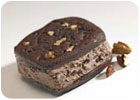
Kudos to inclusion suppliers for incessant innovation. Some mix-ins for ice cream products are downright amazing. (In fact, some are so good, I say skip the ice cream and give me a bowl of the mix-ins!)
As these inclusions have become more sophisticated, it has become necessary for ice cream manufacturers to take a few extra steps to ensure quality. I figured I would find out for you what needs to be done.
Dairy Foods' columnist and resident ice cream expert Steve Young says this. "Inclusions, whether particulate or syrup, must be able to physically withstand the rigors of the injection process and any downstream mechanical effects that might be applied before eventual flow into the package and hardening," he says. "That means the inclusion must have the physical strength to withstand fruit feeder and/or syrup injector designs and conditions and the viscosity of the ice cream itself.
"This can be accomplished by managing inclusion size and shape (small vs. large particulates, thick vs. thin ribbons, etc.), adding physical strength to the inclusion itself (firmness, viscosity, resistance to breakage, resistance to melting, coating, etc.), managing the conditions (feed rates, temperatures, injector design, etc.) under which it is added and/or managing the flow of both inclusion and ice cream into each other and ultimately together into the package," Young says.
According to John Namy, v.p. of culinary development at Dallas-based Pecan Deluxe Candy Co., "As we are developing multi-textured inclusions with our customers, we often ask: How is the plant going to run this product?; Should adjustments be made to their equipment?; Will the inclusion survive the process and maintain its integrity if it goes through a fruit feeder, star wheel or shaker?; Should the product be frozen or tempered prior to handling?," he says. "For example, if the product should remain frozen, you may want to consider bringing fewer pallets out to the production floor at a time."

Melding flavors together
Richard Hauber, R&D director, frozen desserts, Kerry Sweet Ingredients, New Century, Kan., adds, "All of the layered inclusions we create are formulated to function as one piece. For instance, we have a layered tiramisu dessert inclusion that has been formulated to physically act as one piece so that the layers stick together."So what are some of the newest innovations in the world of ice cream inclusions? "Sweet and savory," says Jamie Cutler, senior project specialist at Pecan Deluxe. "We have made a cream cheese ice cream using our new cream cheese base, topped with raspberry chipotle sauce, bacon and chives. This gives the taste buds a real flavor sensation.
"Gelato is hot, too," continues Cutler. "Our research has proven that consumers are intrigued by the whole concept. Tropical fruit combinations are all the rave as well, for example, roasted banana and chipotle pecans, key lime and mango, ginger and pineapple. The list goes on."
There's increasing interest in Hispanic flavors, too. "Our Caramel-Cinnamon Sopapilla features dulche de leche ice cream swirled with a brown sugar variegate and sprinkled with cinnamon sopapilla pieces," says Hauber. "And if there's anyway to provide a health twist, we are on top of it. For example, our new Blueberry Pomegranate Chunk is an all-natural blueberry and pomegranate flavored ice cream with a blueberry variegate and omega-3 fortified walnut bark chips.

Byrd adds, "Some of the better-for-you coatings that we have recently developed include functional food components. Ice cream manufacturers are realizing that inclusions can be boosted to add not only excitement in taste but healthful benefits."
From Young's years of ice cream manufacturing experience, he says, "I have always thought that inclusions were a near perfect way to introduce novel flavors, nutrients and more complex nutraceuticals without seriously impacting base mix properties or introducing more base mixes to plant operations."
It sounds to me like it will be an interesting year ahead for ice cream. I have my spoon ready.